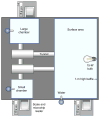Effects of Chronic Social Stress on Obesity
- PMID: 22943039
- PMCID: PMC3428710
- DOI: 10.1007/s13679-011-0006-3
Effects of Chronic Social Stress on Obesity
Abstract
The prevalence of overweight and obesity has markedly increased during the past few decades. Stress has been suggested as one environmental factor that may contribute to the development of obesity. In this review, we discuss the role that exposure to chronic stress may play in the development of obesity, with particular attention to the effects of chronic psychosocial stress. Of particular importance is the effect that social stress has on dietary preference, food consumption, and regional distribution of adipose tissue. We present evidence from human and animal studies that links sympathetic nervous system and hypothalamic-pituitary-adrenal axis hyperactivity with visceral obesity, and that stress tends to alter the pattern of food consumption, and promotes craving of nutrient-dense "comfort foods." Lastly, we discuss the visible burrow system, a model of chronic social stress used in our laboratory to assess the effects of social subordination on behavioral and metabolic profile.
Conflict of interest statement
Figures
Similar articles
-
Metabolic consequences and vulnerability to diet-induced obesity in male mice under chronic social stress.PLoS One. 2009;4(1):e4331. doi: 10.1371/journal.pone.0004331. Epub 2009 Jan 30. PLoS One. 2009. PMID: 19180229 Free PMC article.
-
Hypothalamic-pituitary-adrenal axis activity and its relationship to the autonomic nervous system in women with visceral and subcutaneous obesity: effects of the corticotropin-releasing factor/arginine-vasopressin test and of stress.Metabolism. 1996 Mar;45(3):351-6. doi: 10.1016/s0026-0495(96)90290-5. Metabolism. 1996. PMID: 8606643 Clinical Trial.
-
So as we worry we weigh: Visible burrow system stress and visceral adiposity.Physiol Behav. 2017 Sep 1;178:151-156. doi: 10.1016/j.physbeh.2017.01.019. Epub 2017 Jan 12. Physiol Behav. 2017. PMID: 28089705 Review.
-
[Psychosocial factors as predictors of atherosclerosis and cardiovascular events: contribution from animal models].G Ital Cardiol (Rome). 2006 Nov;7(11):747-53. G Ital Cardiol (Rome). 2006. PMID: 17216916 Review. Italian.
-
Do stress reactions cause abdominal obesity and comorbidities?Obes Rev. 2001 May;2(2):73-86. doi: 10.1046/j.1467-789x.2001.00027.x. Obes Rev. 2001. PMID: 12119665
Cited by
-
The brain on stress: Insight from studies using the Visible Burrow System.Physiol Behav. 2015 Jul 1;146:47-56. doi: 10.1016/j.physbeh.2015.04.015. Physiol Behav. 2015. PMID: 26066722 Free PMC article. Review.
-
The effect of chronic stress and its preconditioning on spatial memory as well as hippocampal LRP1 and RAGE expression in a streptozotocin-induced rat model of Alzheimer's disease.Metab Brain Dis. 2022 Dec;37(8):2699-2710. doi: 10.1007/s11011-022-01044-y. Epub 2022 Aug 5. Metab Brain Dis. 2022. PMID: 35930096
-
Effect of chronic psychosocial stress on nonalcoholic steatohepatitis in mice.Int J Clin Exp Pathol. 2013 Jul 15;6(8):1585-93. Print 2013. Int J Clin Exp Pathol. 2013. PMID: 23923077 Free PMC article.
-
Interoceptive modulation of neuroendocrine, emotional, and hypophagic responses to stress.Physiol Behav. 2017 Jul 1;176:195-206. doi: 10.1016/j.physbeh.2017.01.027. Epub 2017 Jan 14. Physiol Behav. 2017. PMID: 28095318 Free PMC article. Review.
-
The relative contributions of behavioral, biological, and psychological risk factors in the association between psychosocial stress and all-cause mortality among middle- and older-aged adults in the USA.Geroscience. 2021 Apr;43(2):655-672. doi: 10.1007/s11357-020-00319-5. Epub 2021 Jan 28. Geroscience. 2021. PMID: 33511488 Free PMC article.
References
-
- Flegal KM, Carroll MD, Ogden CL, Curtin LR. Prevalence and trends in obesity among US adults, 1999–2008. JAMA. 2010;303 (3):235–41. - PubMed
-
- Selassie M, Sinha AC. The epidemiology and aetiology of obesity: a global challenge. Best Pract Res Clin Anaesthesiol. 2011;25 (1):1–9. - PubMed
-
- Keith SW, Redden DT, Katzmarzyk PT, et al. Putative contributors to the secular increase in obesity: exploring the roads less traveled. Int J Obes (Lond) 2006;30(11):1585–94. - PubMed
Grants and funding
LinkOut - more resources
Full Text Sources
Miscellaneous

